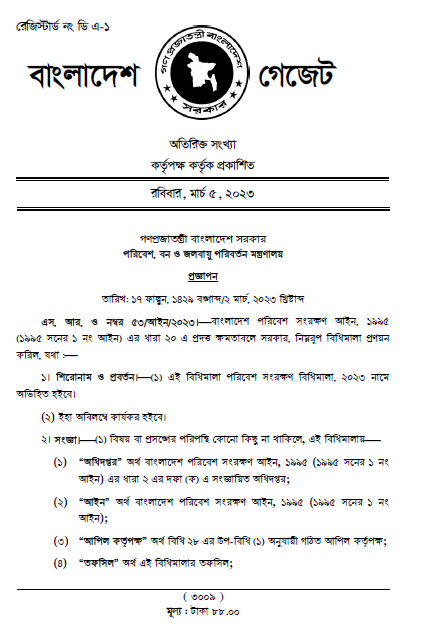The Ministry of Environment, Forest and Climate Change of Bangladesh enacted the Environmental Conservation Rules (ECR) 2023 to implement the Environmental Conservation Act 1995. The rules have been effective from March 5, 2023, by repealing the Environmental Conservation Rules 1997.

The rules set boundaries for industries of Bangladesh to limit the environmental burden of their operations. As per rules, wastewater must follow a set of standards to be discharged into the environment. The standards limit the pollutants to contain these pollutants from damaging the environment as well as surrounding people. Specific standards have been set for the wastewater of different industries present in the country and not meeting these parameters leads to legal issues as per the Environmental Conservation Act 1995.

In the ECR 2023, limits for some new parameters of textile wastewater have been included and some parameters have been updated that will require the textile dyeing, printing, and washing industries to update the wastewater treatment process in many cases.
The maximum limit standards for color, temperature, and chemical oxygen demand (COD) are new in the ECR 2023 compared to the ECR 1997. The maximum limit for color is set to 150 Hazen (Pt-Co), for COD it is 200 mg/L. And, the temperature of the wastewater can not be more than 5 °C above the temperature of the water body where the wastewater will be discharged.
| Parameter | Unit | Maximum Limit |
| pH | – | 6-9 |
| Color | Hazen (Pt-Co) | 150 |
| Temperature | °C | Maximum 5 °C above the temperature of the water body |
| Suspended Solids (SS) | mg/L | 100 |
| (BOD5 at 20 °C) | mg/L | 30 |
| COD | mg/L | 200 |
| Total Dissolved Solid (TDS) | mg/L | 2100 |
| Oil & Grease | mg/L | 10 |
Figure 3: Maximum limit for the parameters of the textile wastewater (ECR 2023).
The biochemical oxygen demand (BOD) maximum limit has been reduced to 30 mg/L from 100 mg/L in the new rules. The pH limit is now 6-9 which was 6.5-9 in the ECR 1997.
On top of that, the rules also set maximum limits for some components of colorants used in textile dyeing and printing for wastewater discharge. Limits have been set for Chromium (Cr), Sulfide (S), Phenol Compounds, Lead (Pb), Cadmium (Cd), Cobalt (Co), and Nickel (Ni) which are prevalent in the textile dyes and pigments.
| Parameter | Unit | Maximum Limit |
| Chromium (Cr) | mg/L | 0.5 |
| Sulfide (S) | mg/L | 2.0 |
| Phenol Compounds | mg/L | 1.0 |
| Lead (Pb) | mg/L | 0.1 |
| Cadmium (Cd) | mg/L | 0.02 |
| Cobalt (Co) | mg/L | 0.5 |
| Nickel (Ni) | mg/L | 1.0 |
Figure 4: Maximum limits for some dyes & pigment components (ECR 2023)
The rules also set requirements for getting permission for an Effluent Treatment Plan (ETP) and its operation. The rules made the release of wastewater through the specific discharge points where the parameters of discharged wastewater are monitored properly mandatory.
Now, it has become a new challenge for textile dyeing, printing, and washing units to meet the legal requirements of wastewater discharge. Especially, meeting the reduced BOD limit and the newly added standard for the color of the wastewater. Ultimately these challenges open opportunities for the technology suppliers to come up with their solutions.
















